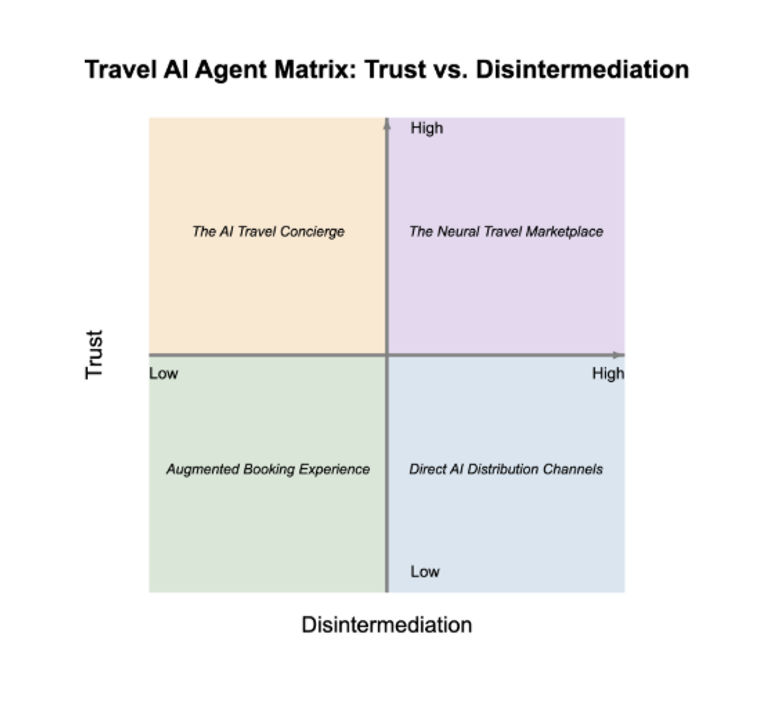At the beginning of January, I wrote a piece challenging the widely accepted narrative that online travel agencies (OTAs) would fade into irrelevance with the rise of artificial intelligence (AI) agents.
Fast forward five months, and the breakneck speed at which agentic AI developments have unfolded may be head spinning—even for the most experienced tech observer. Highlights include:
- New large language models (LLMs) with better reasoning capabilities popping up almost every week
- Google expanding its Gemini suite of LLMs across all possible touch points in its ecosystem (and Meta following suit with Llama)
- ChatGPT and Perplexity launching AI shopping assistant features
- Mastercard and Visa introducing payment options for agentic transactions
- Google announcing an AI Mode with an “agentic checkout” feature that can purchase products on your behalf with Google Pay
- A new protocol, model context protocol (MCP), becoming the de facto standard for AI agents’ interoperability with any online application
With this flurry of agentic AI updates, the questions about winners and losers and how to navigate the changing travel landscape must occupy the center stage of strategic boardroom discussions across the travel industry.
Will customers trust and allow AI agents to autonomously handle their entire customer journey, from planning to buying? Will OTAs adapt and protect their control over the distribution landscape, or will AI agents bypass OTAs connect directly with travel suppliers?
The following matrix—where the axes represent the two critical dimensions (trust and disintermediation)—allows us to map four distinctive future scenarios.
Scenario One: Augmented booking experience (low trust, low disintermediation)
When I open my OTA app, its recommendation engine has already analyzed my past stays and current search patterns to surface properties that match my preferences with uncanny accuracy.
The travel booking experience has been incrementally transformed by AI-powered tools that make existing processes more efficient without fundamentally changing industry relationships.
Subscribe to our newsletter below
In this situation, the interface remains familiar, but interactions have become more conversational. The system doesn’t make final decisions, but it dramatically narrows my options, reducing search fatigue while still giving me control.
OTAs that successfully navigate the transformation still invest heavily in customer acquisition, with the bulk of their budgets being sponsored ads embedded in AI-powered Chatbot answers. Travel brands bid on contextual chat exchanges combined with traveler personas and journey stages rather than simple keyword terms. Google still reigns, but alternative AI chatbots become real alternatives to the search giant.
Key recommendations for OTAs:
- Allow human oversight: Design AI features that complement rather than replace human decision-making. The sweet spot is a tool that dramatically narrows options while letting travelers maintain final control.
- Invest in your API infrastructure: Success in this depends on developing an application programming interface (API) infrastructure that makes your offerings and unique value proposition easily discoverable and searchable by AI chatbots
- Evolve your search marketing strategy: Prepare for the shift from keyword to long queries and intent-based targeting, developing sophisticated feedback loops of travelers to identify high-value prospects earlier in their journey.
Scenario Two: The AI travel concierge (high trust, low disintermediation)
I message my AI travel assistant: “Plan my anniversary trip to Portugal in September, 10 days, with a mix of city and coastal experiences, around $6,000 all-in.”
My AI assistant picks the best bidder on its OTA shortlist—the one offering the most suitable travel itinerary, including flights, hotels and daily activities. After a quick review I simply respond: “Book it.” My calendar is automatically updated with travel details.
In this scenario, where personal AI agents have become trusted assistants, the distribution structure remains largely unchanged—OTAs’ technical capabilities combined with their massive marketing budgets have positioned them as the go-to place for AI systems to efficiently and profitably navigate users’ travel requests.
The bulk of OTAs’ search marketing budgets transitions to what the industry calls “agent access fees”—payments to secure preferential positioning within AI concierge systems. Rather than bidding on keywords, travel brands now compete for algorithmic preference among leading AI agents.
Remaining budgets are split between content marketing focused on establishing expertise credentials that influence AI systems and direct-to-consumer brand building designed to create “pull-through” demand that travelers specifically request from their AI assistants.
Key recommendations for OTAs:
- Invest into AI agent integrations: Enhance your existing API infrastructure with the latest agentic tech stack standards, such as agent-to-agent and MCP, providing the protocols for agent communication and tool use.
- Develop your AI influence strategy: Create structured data feeds that communicate your unique value propositions to AI systems. Identify and emphasize attributes that drive algorithmic preference and trust in AI concierge systems.
- End-to-end journey orchestration: Serve more complex travel journey requests, investing in vertical travel integrations and capabilities to manage complete itineraries to make the most out of the agentic travel requests.
Scenario Three: Direct AI distribution channels (low trust, low disintermediation)
I open the Hilton app and chat with their AI bots about an upcoming trip to Chicago for a conference. The AI suggests specific options with personalized rationales: “The Hilton McCormick Place connects directly to the convention center and has upgraded its executive lounge, which you’ve rated highly in past stays.”
When I select my option, the bot doesn’t just confirm availability but offers a personalized package including my preferred room type, airport transfer and breakfast preferences I’d indicated in previous stays.
The entire transaction occurs within the Hilton ecosystem, yet I maintain control throughout the process, verifying recommendations and making final selections myself. The experience combines the convenience of direct booking with personalization that previously required an intermediary aggregating my preferences across suppliers.
In this scenario, large suppliers’ marketing spend has shifted from acquisition to retention. OTAs’ shrinking business translates into a dramatic decline of ad revenue for digital gatekeepers, and once popular travel comparisons products like Google Flights or hotel search become a relic of the past.
Key recommendations for travel suppliers:
- Customer data strategies must evolve: Success requires capturing and leveraging customer data traditionally held by intermediaries. Develop strategies to enrich your first-party data assets and build comprehensive customer profiles.
- Direct booking incentives shift: Move beyond simple price discounts toward exclusive personalized offerings that demonstrate your understanding of individual travelers.
- Experience integration becomes crucial: Travelers expect comprehensive solutions, not just core products. Develop partnership networks with complementary experience providers that can be integrated into your direct booking path.
Scenario Four: The neural travel marketplace (high trust, high disintermediation)
I tell my personal AI assistant: “I need to be in Singapore for meetings the second week of June. Build me a suitable itinerary.” Behind the scenes, my AI agent interfaces directly with the AI agents from airlines and hotels, each autonomously authorized to customize offerings and complete transactions. Without human intervention, these systems conduct complex, instantaneous algorithmic negotiations, considering factors from my preferred seat positions to my historical sensitivity to hotel room noise.
In this landscape ruled by AI agents, OTAs are gradually fading into irrelevance, and the concept of “end consumer marketing,” as we know it, largely disappears. Marketing budgets in travel have been mostly reallocated to AI agent referral fees ensuring preferred access to customers’ AI assistants, owned by the big tech giants. The traditional marketing teams have merged with product development and data science that design agentic bidding and negotiation algorithms.
Key recommendations for travel suppliers:
- Agentic data strategy becomes existential: Your ability to train AI to optimize agentic bidding depends on data quality and quantity. Capturing structured data about agentic interactions and end customer satisfaction is foundational for success.
- Develop algorithmic bidding and pricing sophistication: The winners will deploy dynamic pricing systems that can autonomously optimize agentic bidding and customize offers and prices of agentic searches.
- Focus on core value creation: As distribution becomes increasingly automated, competitive advantage shifts to creating distinctive travel offers that are easily identifiable by AI agents.
Planning for an uncertain future
The tectonic shifts the travel landscape will face in the coming years will be as deep and far-reaching as the internet revolution. We don’t know which future will ultimately dominate the industry landscape.
Forward-thinking companies will invest in building a flexible data architecture, foundational AI technologies and organizational competencies, giving them the agility to adapt to whichever future scenarios become dominant.
The winning strategy isn’t predicting the future—it’s building the capability portfolio that allows you to succeed in any future.
About the author…




:max_bytes(150000):strip_icc():format(jpeg)/TAL-header-pool-flamingo-las-vegas-NEWVEGASPOOL0525-fefa678a41304ab89eb35e186c5629f6.jpg?w=150&resize=150,150&ssl=1)



